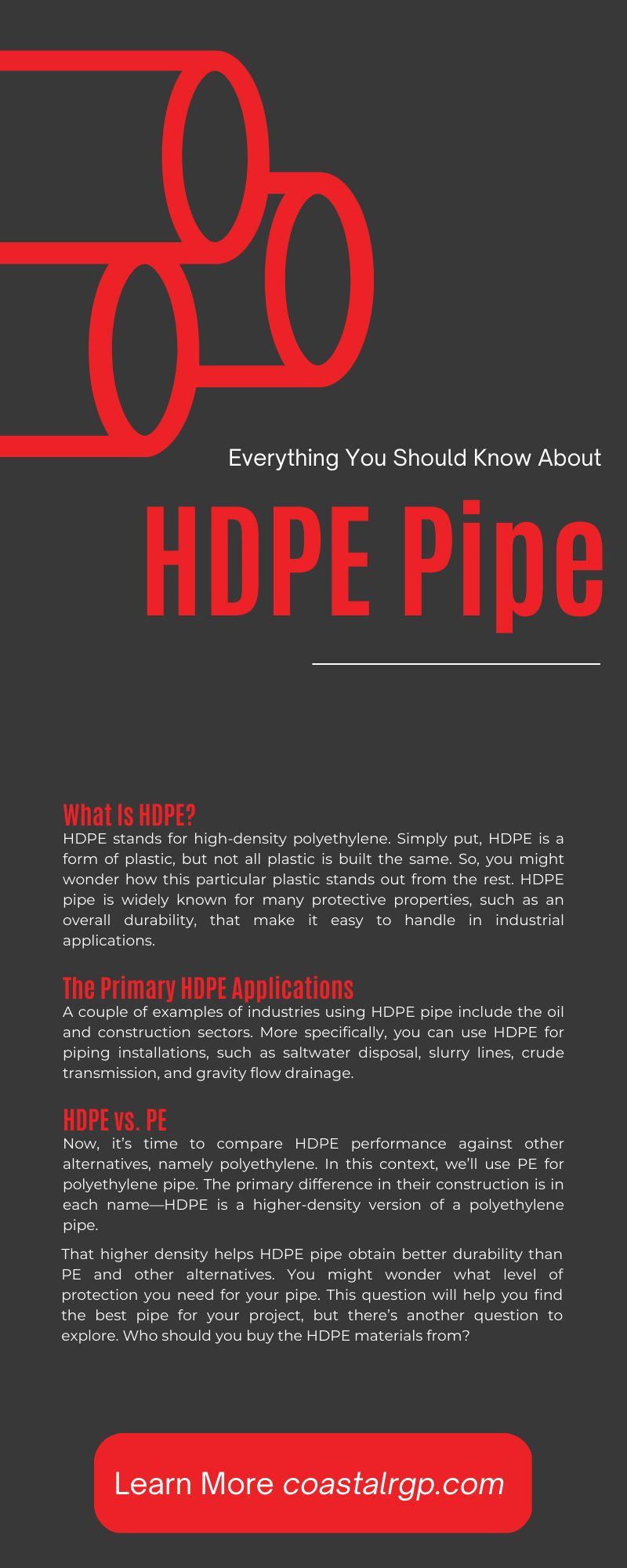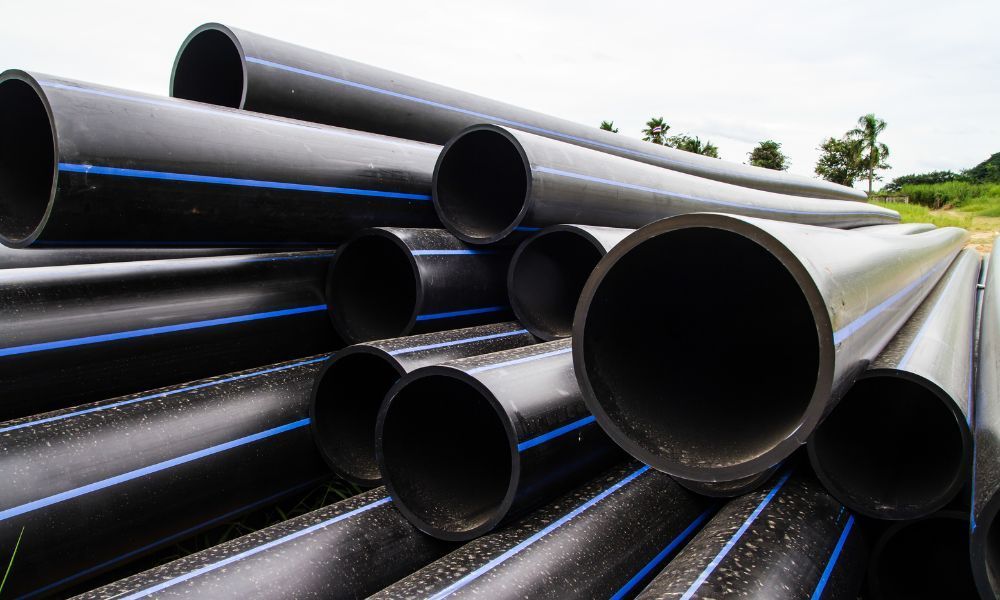When working with a pipe in a wide range of applications, you have to know precisely what you’re dealing with. That may sound obvious to many professionals, but a pipe comes in many variations. After all, a pipe transports many materials, each requiring specific materials to stay properly contained.
Exploring the boundaries of what each pipe material can do is invaluable. The more you know about the industrial pipe options available, the more precisely and responsibly you can pull your project together. For example, if you’re out of the loop about HDPE pipe, then you’re unaware of a very strong, reliable construction material. Continue below for everything you should know about HDPE pipe.
What Is HDPE?
Before discussing the benefits of HDPE, we must explain what the acronym means. HDPE stands for high-density polyethylene. Simply put, HDPE is a form of plastic, but not all plastic is built the same. So, you might wonder how this particular plastic stands out from the rest. HDPE pipe is widely known for many protective properties, such as an overall durability, that make it easy to handle in industrial applications. In addition, HDPE is commonly known for its specific defensive capabilities, including corrosion resistance and chemical resistance.
HDPE piping is also frequently used for its ability to handle high pressure and temperatures, which may cause weaker plastics to break over time. If you’re worried about the pipe easily breaking with your application, then HDPE may be the right answer. Before making that decision, let’s take a closer look at how various industries successfully use HDPE pipe.
The Primary HDPE Applications
Now that you know what HDPE is capable of, it shouldn’t be a surprise to learn that it’s common in heavy-duty industrial settings. A couple of examples of industries using HDPE pipe include the oil and construction sectors. More specifically, you can use HDPE for piping installations, such as saltwater disposal, slurry lines, crude transmission, and gravity flow drainage.
You can also see HDPE pipe in more general drainage systems, meaning they can handle many different projects. For instance, storm sewers and septic systems rank among the most common HDPE applications. You can find HDPE pipe in extensive designs thanks to their endless application possibilities, but they ultimately focus on proper defense against corrosion and other harmful elements.
An Easy, Effective Drainage Option
Simplifying any construction project without compromising high-quality results is possible. As mentioned above, HDPE can accomplish many heavy-duty drainage solutions. Thus, you may assume it is a complex material to handle. This is not the case. One key benefit of HDPE pipe is they are lightweight. Remember that even HDPE comes in variations, so their weight can differ. Still, their performance will excel.
At Coastal Resource Group, we have single-wall HDPE ADS polyethylene pipe that works exceptionally in septic systems, side drains, culverts, and more. We offer all types of HDPE pipe. Our inventory can help you with single wall corrugated drainage applications or pressure applications in diameters—up to 48” IPS in RD’s from RD7-RD41.
Standard dimension ratio (SDR) is another key measurement to remember. SDR, also known as dimension ratio (DR), is a pipe’s pressure rating. This measurement is taken by looking at the diameter from the outside and the minimum wall thickness of the pipe. The higher the SDR, the thinner the wall. A high SDR pipe is better for low-pressure applications. On the other hand, a low SDR pipe is ideal for handling high pressures.
Each pipe is made by our team using the highest-quality resins rated PE-4710 and/or PE-100. If you’re looking at a listing that reads something like 12,500’-12” Pipe HDPE DR11 PE4710, you should have a firmer grasp on what all those acronyms and numbers mean. Our pipe is endorsed by the Plastic Pipes Institute. You’ll even find our pipe in the Institute’s Technical Report 4 (TR4).
Assessing Performance & Installation
Don’t assume that extra protection provided by an HDPE pipe won’t come at the cost of excessive weight increases. When building anything, even minimal weight differences are essential to balance if you want a functioning system.
Luckily, HDPE can help you find a good balance between healthy weight and durable construction. This isn’t the only factor that makes HDPE pipe easy to use. The material is also flexible, which makes it easy to fit into your installation area, whether that’s a storm drain, slurry line, or something else entirely.
The simplicity and speed of installation are reasons why HDPE is often seen as a cost-effective piping solution. Moreover, that cost-effectiveness comes in the form of its longevity. Thanks to its impact resistance, chemical resistance, and more defenses, HDPE won’t be easily broken by the same things that can harm polyethylene and other weaker materials. This also means you can worry less about maintenance costs. Still, you should always talk specifics with your supplier so you know precisely how to prepare.
You may assume that HDPE’s performance makes it an expensive option. Thankfully, that’s not true. This is a key reason why browsing your HDPE pipe suppliers carefully is crucial so you can find the best value. If you need more flexibility in your drainage project, then explore HDPE as a potential option. What other options are available for building your drainage system, and why not use them?
HDPE vs. PE
Throughout this discussion, there’s been a focus on how HDPE excels over other alternatives, but we have yet to explore those other options. Now, it’s time to compare HDPE performance against other alternatives, namely polyethylene. In this context, we’ll use PE for polyethylene pipe. The primary difference in their construction is in each name—HDPE is a higher-density version of a polyethylene pipe.
That higher density helps HDPE pipe obtain better durability than PE and other alternatives. You might wonder what level of protection you need for your pipe. This question will help you find the best pipe for your project, but there’s another question to explore. Who should you buy the HDPE materials from?
Finding the Right Supplier
Discussing everything you should know about HDPE pipe requires us to cover the manufacturers, too. How do you sift through HDPE pipe providers to find a reliable option? Suffice it to say that the last thing you want is to build drainage systems with materials that are less durable or reliable than you expect. So, compare the options available to see whose price and industry experience best reflect what you’re looking for in a provider.
You should look at the variations of HDPE designs manufacturers provide. As mentioned previously, HDPE pipe can be built in different ways. For example, our ADS polyethylene pipe at Coastal Resource Group can be perforated or non-perforated—whichever is best for your project. Likewise, the openings in the pipe can differ in design, with options including uniform slots and drilled holes. While you may not need every variation, it helps to know the extent of your supplier’s abilities. Start navigating your options today to find a skilled, reliable HDPE pipe supplier for your next drainage project.



